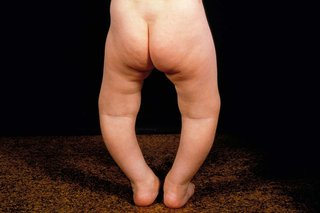Symptoms of rickets or osteomalacia
The main symptom of rickets is having bowed legs. This is when your legs curve outward so there's a large gap between your knees when you stand with your feet together.

Symptoms of rickets in children and osteomalacia in adults also include:
- swollen, painful wrists
- pain in your back, shoulder, ribs, pelvis or legs
- changes in the way you walk, not wanting to walk much or getting tired more easily when walking
- difficulty climbing stairs or getting out of a chair because of weak muscles
- tingling, cramping or twitching of your muscles
- breaking your bones more often or after a minor accident, especially your hips, lower back and feet
Children with rickets may be small for their age and their teeth may come through later than usual.
Non-urgent advice: See a GP if:
- you think you or your child might have rickets or osteomalacia
What happens at your GP appointment
If a GP thinks you or your child may have rickets or osteomalacia, they'll check your vitamin D and calcium levels.
This may include having blood tests and testing a sample of your pee.
They may also refer you to a specialist for more tests, such as X-rays and bone scans.
Treatment for rickets and osteomalacia
Rickets and osteomalacia are usually caused by low levels of vitamin D and calcium in your body.
Our bodies make vitamin D when our skin is exposed to summer sunlight. But we cannot make enough vitamin D from sunlight between September and March, which can cause low vitamin D levels.
Calcium is found in milk, cheese, yoghurt and green leafy vegetables, as well as other foods. You may not get enough if you do not have a healthy, balanced diet.
Treatments for rickets include:
- taking vitamin D and calcium supplements
- having a healthy, balanced diet
- spending more time outside with the sun on your skin, which is a good way to increase your vitamin D levels naturally
Spend time in the shade when the sun is at its strongest. In the UK, this is between 11am and 3pm from late March to September.
If rickets or osteomalacia have caused problems with your bones, such as bowed legs, you may need further treatment to fix this. Some people may need surgery.
If your rickets or osteomalacia symptoms are caused by another condition, treating that condition will help.
Preventing rickets and osteomalacia
You can prevent rickets and osteomalacia by making sure you get enough vitamin D and calcium.
Do
-
take a vitamin D supplement, especially if you're over 65, or pregnant or breastfeeding
-
give your baby vitamin D drops from birth if they're exclusively breastfed or under 6 months old and have less than 500ml of formula a day
-
eat a healthy, balanced diet
-
try to get outside in the sun without wearing sunscreen for 15 minutes 2 or 3 times a week between late March and September – this may be more often if you have brown or black skin
Some families can get free vitamin supplements for their children as part of the Healthy Start scheme.
Find out how to apply for Healthy Start
You can also apply by calling the Healthy Start helpline on 0300 330 7010 or emailing healthy.start@nhsbsa.nhs.uk.
Page last reviewed: 09 July 2025
Next review due: 09 July 2028